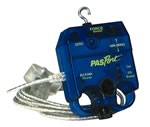Pasco and Archimedes
Just a quick note that one class attempted to use the Pasco Force probes to do a lab on Archimedes Principle. I don't really know how well it went, because I didn't give them a procedure (that's my usual treatment for honors or AP) and I haven't graded them yet. But the general point here is that any lab that could make use of a spring scale or a triple beam balance, could probably use a force sensor to do the trick. That's no justification for buying the probeware, but if you are getting the probeware anyway for labs on friction, Newton's laws, Hooke's Law, etc, then keep in mind that they can be used for this sort of thing as well.

The typical procedure I saw being used by the lab groups involved a graduated cylinder and several brass weights. The students determined the volume of each brass weight by seeing how much the water level went up when the weight was dropped into the cylinder... and then the lab group would argue about how to use this information to calculate the buoyant force. The trick of course is that for any object submerged in water, the buoyant force will be ~10N per liter of space the object takes up. I am hoping that when I go to grade the labs, most of them will show that they did this part properly, but I have seen in the past that many students have trouble keeping straight the difference between the density of water and the density of the object displacing water. We shall see.
As for the experimental part of the lab, they all seem to have figured out that they could use the force sensor to hang the brass weight from a string and record the weight, then lower the weight into the water and see what it weighs while submerged. I really should have made them turn in a procedure before hand, because a few of the groups doubtless enacted this procedure after seeing everybody else was doing it.
Wish me luck. I will be drafting a step-by-step procedure for my standard-level classes to use for this lab. They'll probably be doing it next week. And keep an eye out for a Hooke's Law lab - AP just did that using both a force sensor and a motion sensor, and I will post their various procedures as soon as I have a chance to read through them.

The typical procedure I saw being used by the lab groups involved a graduated cylinder and several brass weights. The students determined the volume of each brass weight by seeing how much the water level went up when the weight was dropped into the cylinder... and then the lab group would argue about how to use this information to calculate the buoyant force. The trick of course is that for any object submerged in water, the buoyant force will be ~10N per liter of space the object takes up. I am hoping that when I go to grade the labs, most of them will show that they did this part properly, but I have seen in the past that many students have trouble keeping straight the difference between the density of water and the density of the object displacing water. We shall see.
As for the experimental part of the lab, they all seem to have figured out that they could use the force sensor to hang the brass weight from a string and record the weight, then lower the weight into the water and see what it weighs while submerged. I really should have made them turn in a procedure before hand, because a few of the groups doubtless enacted this procedure after seeing everybody else was doing it.
Wish me luck. I will be drafting a step-by-step procedure for my standard-level classes to use for this lab. They'll probably be doing it next week. And keep an eye out for a Hooke's Law lab - AP just did that using both a force sensor and a motion sensor, and I will post their various procedures as soon as I have a chance to read through them.



0 Comments:
Post a Comment
<< Home